

Religion vs. Humanism: Isaac Asimov on Science and Spirituality. By Maria Popova “The soft bonds of love are indifferent to life and death.” Science and religion have a long history of friction as diametric opposites. But some of humanity’s greatest minds have found in science itself a rich source of spirituality, from Albert Einstein’s meditation on whether scientists pray to Richard Feynman’s ode to the universe to Carl Sagan on the reverence of science to Bucky Fuller’s scientific rendition of The Lord’s Prayer to Richard Dawkins on the magic of reality . 8 math talks to blow your mind. Mathematics gets down to work in these talks, breathing life and logic into everyday problems.
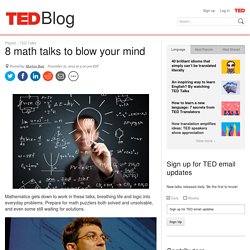
Internet access is a basic human right: A Q&A with Keren Elazari. Keren Elazari speaks at TED2014.
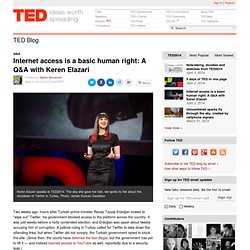
The day she gave her talk, we spoke to her about the shutdown of Twitter in Turkey. Photo: James Duncan Davidson Two weeks ago, hours after Turkish prime minister Recep Tayyip Erdoğan vowed to “wipe out” Twitter, his government blocked access to the platform across the country. It was just weeks before a hotly contended election, and Erdoğan was upset about tweets accusing him of corruption. A judicial ruling in Turkey called for Twitter to take down the offending links, but when Twitter did not comply, the Turkish government opted to block the site.
Other governments have also tried to block access to parts or all of the Internet in the past, including Egypt’s Internet shutdown in January 2011 and Syria’s in May 2013. In her talk, Elazari said that hackers play an essential role in giving power, or free access to information, back to the people when governments try to take it away. Edward Snowden: Here's how we take back the Internet. The infinite life of pi - Reynaldo Lopes. The Science of Our Warped Perception of Time, Animated. Dan Meyer: Math class needs a makeover. The history of marriage - Alex Gendler. We Are Singing Stardust: Carl Sagan on the Story of Humanity’s Greatest Message and How the Golden Record Was Born. By Maria Popova.

The Science of Our Optimism Bias and the Life-Cycle of Happiness. By Maria Popova “To make progress, we need to be able to imagine alternative realities, and not just any old reality but a better one.” Mathemusician Vi Hart Explains Space-Time with a Music Box and a Möbius Strip. Sleep and the Teenage Brain. By Maria Popova How a seemingly simple change can have a profound effect on everything from academic performance to bullying.

“Sleep is the greatest creative aphrodisiac,” Debbie Millman asserted in her advice on breaking through your creative block. “Sleep deprivation will profoundly affect your creativity, your productivity, and your decision-making,” Arianna Huffington cautioned graduating seniors in her Smith College commencement address on redefining success. Interpreting the Data: 10 Ways to Teach Math and More Using Infographics. From stock prices and unemployment rates to trends in tuition and quality of life, the ability to understand and interpret quantitative data is more important than ever in understanding the world.
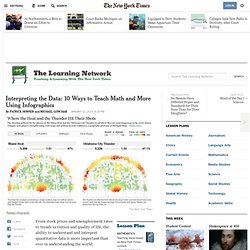
Over the years we’ve written many posts about teaching with Times infographics, including a 2010 series about using them across the curriculum, and a 2011 lesson called “Data Visualized: More on Teaching With Infographics.” Brené Brown on Vulnerability, Human Connection, and the Difference Between Empathy and Sympathy, Animated. Shereen El Feki: A little-told tale of sex and sensuality. 189, Stephen King. Stephen King began this interview in the summer of 2001, two years after he was struck by a minivan while walking near his home in Center Lovell, Maine.

Salman Khan doubles down on building the school of the future. When Salman Khan shared his vision for “a free world-class education for anyone anywhere” at TED2011, he turned the education world on its head.
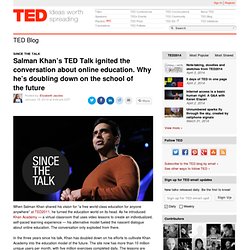
As he introduced Khan Academy — a virtual classroom that uses video lessons to create an individualized, self-paced learning experience — his alternative model fueled the nascent dialogue about online education. The conversation only exploded from there. In the three years since his talk, Khan has doubled down on his efforts to cultivate Khan Academy into the education model of the future. The site now has more than 10 million unique users per month, with five million exercises completed daily.
The lessons are available in 29 languages, and are hosted on five fully translated sites. Khan himself has been busy reimagining the education experience. Khan recently spoke with the TED Blog about Khan Academy’s incredible growth, and what’s on the horizon for classrooms both physical and virtual. Content coverage is a big thing. DON’T PANIC — The Facts About Population. The world might not be as bad as you might believe!
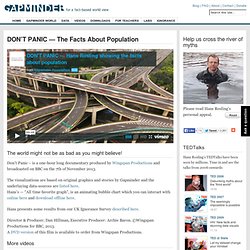
Don’t Panic – is a one-hour long documentary produced by Wingspan Productions and broadcasted on BBC on the 7th of November 2013. The visualizations are based on original graphics and stories by Gapminder and the underlaying data-sources are listed here. Hans’s — “All time favorite graph”, is an animating bubble chart which you can interact with online here and download offline here. Hans presents some results from our UK Ignorance Survey described here. Director & Producer; Dan Hillman, Executive Producer: Archie Baron. More videos. The Woman Who Could Write, But Couldn't Read. One morning, a kindergarten teacher was about to take attendance for her class when she realized she couldn't read the paper in her hands.

She tried looking over her lesson plans, but like the attendance sheet, they seemed to be covered in incomprehensible symbols. She didn't know it yet, but the teacher, identified only as M.P. in a recent case study her doctors published about her in the journal Neurology, had had a stroke. The stroke afflicted a very specific part of her brain, leaving the 40-year-old woman with some unusual, but not unprecedented, symptoms—and plenty of functioning outside of that. 5 Awesome Innovations in 2014. Image credit: iStockphoto Is it just me, or does it seem like things are going a little coocoo?

I know we humans are no strangers to brutality and savage conflict, or scary meteorological anomolies or rampant political corruption. Yet it does seem like we're spinning a little too uncontrollably towards Crazytown. NSA files decoded: Edward Snowden's surveillance revelations explained. Two factors opened the way for the rapid expansion of surveillance over the past decade: the fear of terrorism created by the 9/11 attacks and the digital revolution that led to an explosion in cell phone and internet use.
But along with these technologies came an extension in the NSA’s reach few in the early 1990s could have imagined. Details that in the past might have remained private were suddenly there for the taking. Chris Soghoian.